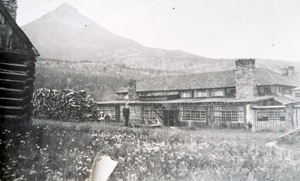News Flashbacks
Estes Park Badly Shaken By '03 Quake; Damage Light
By James R. Miller
Fort Collins Coloradoan, January 7, 1964

Several times during the last year, Coloradoans have been surprised-and no little chagrinned-to learn of the recording of earth tremors of varying intensity over wide areas of the state, but centering usually on the Denver area, and particularly in the vicinity of Adams County, northwest of Denver. For so many years residents of the state had boasted to their friends that, despite its mountainous character, Colorado has no earth quakes, that now it seemed almost a personal affront when a mysterious force began to shatter their theory. As proof of the solidity of the state, they had long pointed to the many delicately poised balanced rocks, which adorn the mountain areas. Some of the recent disturbances, however, were significantly severe that protection against earthquake damage is being given consideration in the designing of large building in Denver. Persons living in Estes Park in the fall of 1903 had no illustrations on the subject, however. The Fort Collins Evening Courier of Sept.10 told the story under an Estes Park dateline: "A violent earthquake shock was felt in the Estes Park section this morning. The shock was felt most severely at places nearest, the range, the heaviest being experienced at Two-Bar Y ranch, Sprague's and at Long's Peak Inn."
"The duration of the earthquake was from 5 to 10 seconds and was proceeded by a deep rumbling sound and followed by rattling sounds lasting several seconds. It awoke people at five minutes before 1 o'clock in every part of the park. No damage, so far as can be learned, was done." On several ranches, cattle were stampeded and many of the residents were badly scared, some jumping from their beds in fright, thinking a volcanic eruption or a general earthquake was on. "Geologists who have examined the mountains of this section have pronounced the formation of distinctively volcanic origins from the headwaters of Fall River, five miles west of the Estes Park post office, to the North Fork of The Poudre, 35 miles north, and in this distance there are at least 12 extinct volcanoes. The nearest and most prominent of these is Specimen Mountain, which has an altitude of 11,500 feet and for 20 miles northwest of the park, in the Mummy Range."
"Specimen Mountain is a mass of geodes and obsidian cinders; mingled with this is quantities of volcanic ash, and for miles around this mountain the country is formed of unglaciated lava. On the west side of the peak, the North Fork of the Grand starts to the Pacific and on the east the Poudre starts for the Atlantic."
In the same issue of the Courier, this item appeared: "A postal from John Zimmerman at home (in Poudre Canyon) states that a lively earthquake shock was felt there at 1 o'clock on Wednesday morning. That old crater up the Poudre Canyon on the Medicine Bow, near Chambers Lake, may be rousing itself from its lethargy to remind the world that it has some vitality left. " Several days later, the Loveland department of the Courier carried this story of the same occurrence: "Two very distinct earthquake shocks were felt here Tuesday night of last week, accompanied by a loud report and rumbling noise. Houses were felt to move perceptibly, and windows and dishes rattled. Some were awakened out of sleep, while many more were awake on account of the fire that was in progress (the burning of the Van Bramer building on Fourth Street.) "Some heard the report but thought it was an explosion. Several businessmen went and examined their safes, thinking the report might have been some effort to blow up a safe or bank vault. The affair caused quite a ripple of excitement. On Saturday evening a light shock was reported from Pinewood, 15 miles west of Loveland, but it was not noticed here."
Although the presence of extinct volcanoes may or may not be justifiably associated with earthquakes, it is a conclusion naturally reached by the average person. Sixty million years ago, take or leave a few million either way, Larimer county lay deep under a great sea which extended from The Gulf of Mexico to The Arctic Ocean and covered the area now known as The Great Plains and The Rocky Mountains. Lush sub-tropical forests grew on the shores of the lake, and fantastic reptiles lolled at the water's edge and fed on the grasses. As this Mesozoic age came to a close, the land lifted and the sea drained. Over long periods of time, the earth buckled and the sedimentary rocks which formed the floor of the sea bowed upward in great folds which became the Rocky Mountains. In this crushing, grinding process, rocks in some places broke and slipped upward along great cracks or faults. Along some of these fractures, molten rock from the interior of the earth poured forth. Here and there volcanoes belched out great clouds of vapor, liquid lava and rock fragments. The Front Range was thus formed.
In his History of Larimer County, Ansel Watrous notes the evidence of volcanic action in this region: "Larimer County prides itself upon having as interesting examples of ancient volcanic disturbances can be as found in the entire Rocky Mountain region. These are found in the vicinity of Cameron Pass, about 75 miles west of Fort Collins. The more marked evidences of volcanic action are near Lake Zimmerman, on the east side of the pass, some miles southeast of Chambers Lake. They form what is known as 'The Craters'.two deep rocky basins divided from each other by a thin knife-like ridge. The northwest walls of 'The Craters' overlook Cameron Pass, and are in the form of a serrated ridge of chimney-like rocks. The rocks, columns and boulders are of flint-like hardness and very finely checked, as if at some time they had been exposed to intense heat. 'The Craters' are the scene of absolute bareness and desolation. So impervious seems the surrounding rock that all the action of the elements for thousands of years past has failed to make the least impression upon them, so that the interstices are devoid of any solid deposits. Consequently, even the hardiest plant has found no foothold among them."
"In the beds of these craters deep snow banks are found which evidently have been forming since the volcanoes cooled off, thousands of years ago and quit belching their streams of fire and mud and clouds of steam. It is thought by scientists that the bed of Lake Zimmerman was at one time the scene of some ancient volcanic eruption. The bed of Lake Agnes is clearly the crater of an ancient volcano." Earthquakes or not, life in Larimer County went on. And the banter between the editors of the newspaper, which was a feature of early journalism, went on. Of the earth tremors, Roy Ray, editor of the Windsor Poudre Valley wrote, "Possibly it was Brother Watrous of the Fort Collins Courier snoring." To that, the Fort Collins editor replied, "Nay, Br'er Ray, it couldn't have been that, for our slumbers are as sweet and peaceful as a new-born babe's. We never took our horn in the night. Perhaps it was the echo of Windsor's boom that shook things up."


Preserving the history of Fort Collins, Colorado & the Cache la Poudre region





